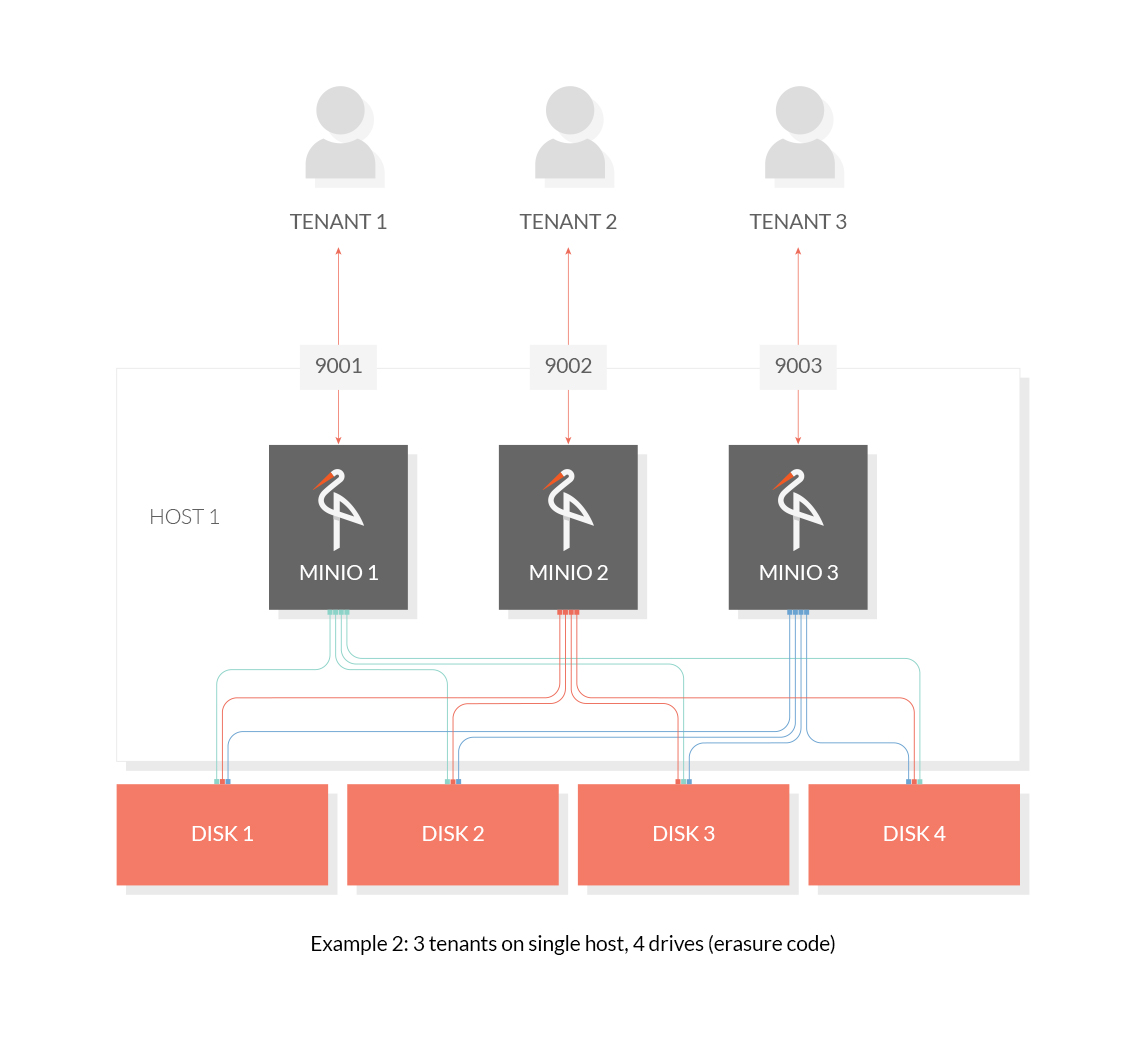# Multi-tenant Minio Deployment Guide [](https://slack.minio.io) [](https://goreportcard.com/report/minio/minio) [](https://hub.docker.com/r/minio/minio/) [](https://codecov.io/gh/minio/minio)
## Standalone Deployment
To host multiple tenants on a single machine, run one Minio server per tenant with dedicated HTTPS port, config and data directory.
#### Example 1 : Single host, single drive
This example hosts 3 tenants on a single drive.
```sh
minio --config-dir ~/tenant1 server --address :9001 /data/tenant1
minio --config-dir ~/tenant2 server --address :9002 /data/tenant2
minio --config-dir ~/tenant3 server --address :9003 /data/tenant3
```

#### Example 2 : Single host, multiple drives (erasure code)
This example hosts 3 tenants on multiple drives.
```sh
minio --config-dir ~/tenant1 server --address :9001 /disk1/data/tenant1 /disk2/data/tenant1 /disk3/data/tenant1 /disk4/data/tenant1
minio --config-dir ~/tenant2 server --address :9002 /disk1/data/tenant2 /disk2/data/tenant2 /disk3/data/tenant2 /disk4/data/tenant2
minio --config-dir ~/tenant3 server --address :9003 /disk1/data/tenant3 /disk2/data/tenant3 /disk3/data/tenant3 /disk4/data/tenant3
```

## Distributed Deployment
To host multiple tenants in a distributed environment, run several distributed Minio instances concurrently.
#### Example 1 : Multiple host, multiple drives (erasure code)
This example hosts 3 tenants on a 4 node distributed setup. Execute the following command on all the four nodes.
```sh
export MINIO_ACCESS_KEY=< TENANT1_ACCESS_KEY >
export MINIO_SECRET_KEY=< TENANT1_SECRET_KEY >
minio --config-dir ~/tenant1 server --address :9001 http://192.168.10.11/data/tenant1 http://192.168.10.12/data/tenant1 http://192.168.10.13/data/tenant1 http://192.168.10.14/data/tenant1
export MINIO_ACCESS_KEY=< TENANT2_ACCESS_KEY >
export MINIO_SECRET_KEY=< TENANT2_SECRET_KEY >
minio --config-dir ~/tenant2 server --address :9002 http://192.168.10.11/data/tenant2 http://192.168.10.12/data/tenant2 http://192.168.10.13/data/tenant2 http://192.168.10.14/data/tenant2
export MINIO_ACCESS_KEY=< TENANT3_ACCESS_KEY >
export MINIO_SECRET_KEY=< TENANT3_SECRET_KEY >
minio --config-dir ~/tenant3 server --address :9003 http://192.168.10.11/data/tenant3 http://192.168.10.12/data/tenant3 http://192.168.10.13/data/tenant3 http://192.168.10.14/data/tenant3
```

*Note*
Please remember that defining and exporting credential environment variables, `MINIO_ACCESS_KEY` and `MINIO_SECRET_KEY` , is **mandatory** on distributed deployments. It is also required to define and export domain environment variable, `MINIO_DOMAIN` , if domain information is needed to be set.
## Cloud Scale Deployment
For large scale multi-tenant Minio deployments, we recommend using one of the popular container orchestration platforms, e.g. Kubernetes, DC/OS or Docker Swarm. Refer [this document ](https://docs.minio.io/docs/minio-deployment-quickstart-guide ) to get started with Minio on orchestration platforms.